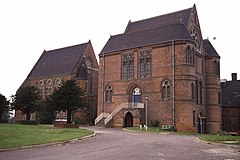The Pumping Station, Whitacre Waterworks
| The Pumping House, Whitacre waterworks | |
|---|---|
 |
|
| General information | |
| Type | Brick |
| Architectural style | Venetian Gothic |
| Town or city | Shustoke |
| Country | England |
| Coordinates | 52°31′07″N 1°41′00″W / 52.518633°N 1.683207°WCoordinates: 52°31′07″N 1°41′00″W / 52.518633°N 1.683207°W |
| Completed | 1883 |
| Owner | Severn Trent Water |
The Pumping Station at Whitacre Waterworks, Shustoke, Warwickshire, is a Victorian Venetian Gothic pumping house built in circa 1860. Along with the construction of Shustoke Reservoir, it was originally designed to pump six million gallons of fresh water per day to nearby Birmingham. It started operating in 1883, but was shortly thereafter in 1904 put into standby as the Elan Valley reservoirs and aqueduct scheme started to supply Birmingham with its fresh water needs. It instead was latterly used in 1908 to supply water to Coventry, and now Nuneaton, Atherstone, and Bedworth. The water supply emanates from the nearby river Bourne and the river Blythe. The pumping station building was listed grade II in March 1982. The listing also covers a Victorian filter house, water well, and Superintendents house.
The pumping station and reservoir originally belonged to the Water Department of the City of Birmingham, but now they are the responsibility of the Severn Trent Water Authority. The reservoir is a popular leisure site for sailing and walking.
Apart from the two clocks, the original pumping machinery and ancillaries have largely been dismantled and replaced with modern equipment. The site was largely extended in 1977 with new more modern works. It is believed to originally have contained two beam engines by James Watt, one of which is now on display in the Science Museum, Birmingham.
The pumping station house is predominantly constructed in red brick with stone dressings, the roofs are generally pitched and tiled in clay, and the eaves decorated with modillion eaves and cornices. The Southeastern part of the building is prominent, with a tall gabled central part with 6 windows in the gable and 3 large gothic windows below. It is flanked by aisled constructions with apsidal ends and with semi-conical roofs. The southwestern end is also prominent, again with large gabled roof, with a semi-circular extension with semi-conical roof on the western end, and a circular corner turret with conical roof on the east. The northern part of the building comprises a large uninterrupted wing, with a longitudinal pitched roof with glazed rooflight ventilators, and seven smaller gabled roofs at right-angles to the main roof. There are many large gothic windows within the various facades.
...
Wikipedia
